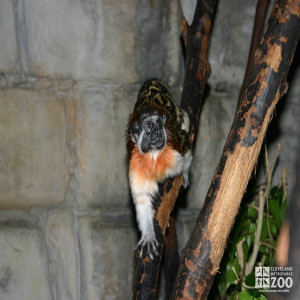Geoffroy's Tamarin
[Saguinus geoffroyi]

Geoffroy's Tamarin is one of the smallest primates, and the most northerly-ranging of the tamarins. Head and body length is from 10 to 12 inches, and the weight is about 18 ounces. The most distinctive marking is a medium, wedge-shaped, white crest, sharply defined from a reddish mantle on the head.
Geoffroy's Tamarin is a diurnal animal, usually covering 1/3 of its home range (.6 to 1.2 square miles) each day, foraging for food. To avoid predators it sleeps in tree hollows at night.
The family groups are small, usually 10 or less. They use calls and scent marking to define their boundaries.Only one female per group breeds during a breeding season, although she may mate with more than one male in the group. Birth weight is usually 9 to 15% of the mother's weight, which is considerably higher than with other primates. All group members take some part in carrying the young, and surrender food morsels to them and the breeding female. So far as it is known, this form of cooperative breeding is unique among primates. By 10 weeks the young are independent, and reach puberty at 12 to 18 months. Cleveland Metroparks Zoo is the stud book keeper for this species. This means that the zoological community recognizes the special expertise of the Cleveland Metroparks Zoo in raising and caring for this species.
Location: The RainForest Atrium
Share:
Range
The range of the Geoffroy's tamarin is Panama, N.W. Colombia, and Costa Rica.
Habitat
Geoffroy's tamarins inhabit tropical and subtropical rainforests and wooded areas.
Conservation Status
Least ConcernPrimary Threats
Human Wildlife CoexistenceGestation
140 to 170 days
Litter
3-Feb
Behavior
Geoffroy's Tamarin is a diurnal animal, usually covering 1/3 of its home range (.6 to 1.2 square miles) each day, foraging for food. To avoid predators it sleeps in tree hollows at night. The family groups are small, usually 10 or less. They use calls and scent marking to define their boundaries.
Reproduction
Only one Geoffroy's tamarin female per group breeds during a breeding season, although she may mate with more than one male in the group. Birth weight is usually 9 to 15% of the mother's weight, which is considerably higher than with other primates. All group members take some part in carrying the young, and surrender food morsels, particularly insects, to them and the breeding female. So far as it is known, this form of cooperative breeding is unique among primates. By 10 weeks the young are independent, and reach puberty at 12 to 18 months.
Wild Diet
Fruit, insects, bird eggs, spiders, leaf buds, flowers, small lizards & frogs, plant gum and nectar
Zoo Diet
Fruit, mealworms, ground beef & cereal mix, marmoset diet, crickets, neonate mice

